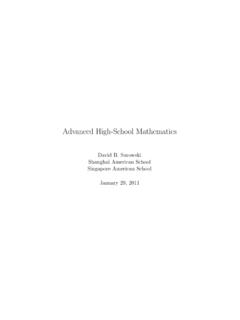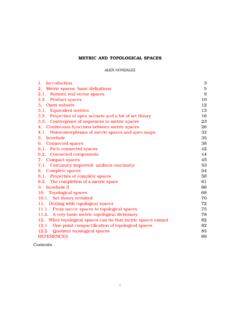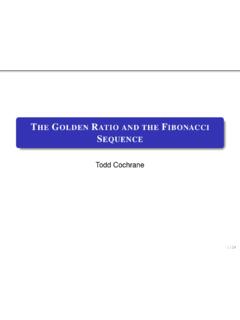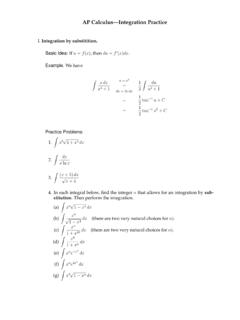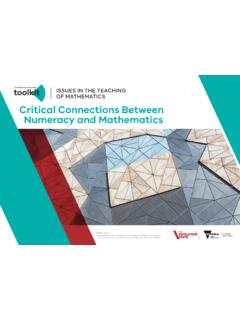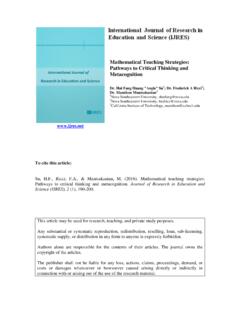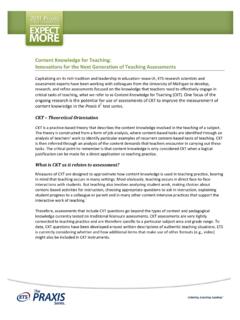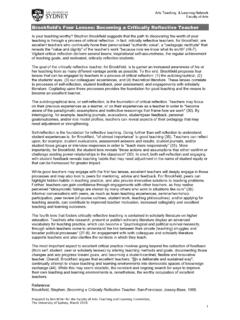Transcription of Functions, Graphs, and Graphing: Tasks, Learning, and …
1 functions , Graphs, and graphing : tasks , learning , and teaching Author(s): Gaea Leinhardt, Orit Zaslavsky and Mary Kay Stein Reviewed work(s): Source: Review of Educational Research, Vol. 60, No. 1 (Spring, 1990), pp. 1-64. Published by: American Educational Research Association Stable URL: . Accessed: 18/10/2012 17:36. Your use of the JSTOR archive indicates your acceptance of the Terms & Conditions of Use, available at .. JSTOR is a not-for-profit service that helps scholars, researchers, and students discover, use, and build upon a wide range of content in a trusted digital archive.
2 We use information technology and tools to increase productivity and facilitate new forms of scholarship. For more information about JSTOR, please contact . American Educational Research Association is collaborating with JSTOR to digitize, preserve and extend access to Review of Educational Research. Reviewof EducationalResearch Spring1990, , No. 1, pp. 1-64. Functions, Graphs, and Graphing: tasks , learning , and teaching Gaea Leinhardt University of Pittsburgh Orit Zaslavsky Technion, Israel and Mary Kay Stein University of Pittsburgh This reviewof the introductoryinstructionalsubstanceof functions and graphs analyzes researchon the interpretationand constructiontasks associated with finctions and some of theirrepresentations:algebraic,tabular,a nd reviewalso analyzesthenatureof learningin termsof intuitionsandmisconceptions, and the plausible approachesto teaching throughsequences,explanations,and examples.
3 The topic is significantbecauseof (a) the increasedrecognitionof the organizingpower of the concept of functionsfrom middle school mathematics throughmore advancedtopics in high school and college, and (b) the symbolic connectionsthatrepresentpotentialsforinc reasedunderstanding betweengraphical and is a reviewof a specificpart of the mathematicssubject matterand how it is learnedand may be taught,this specificityreflectsthe issues raised by recenttheoreticalresearchconcerninghow specificcontextand content contributeto learningand meaning. Introduction This paperis a reviewof researchand theoryrelatedto teachingand learningin a particularsubject, mathematics ;in a particulardomain, Functions, Graphs, and graphing ;at a particularage level, 9-14.
4 Majorreviewsin educationare rarelyso , since 1970, there has been no subjecttopic-specificreview in Review of Educational Research. Recent theoretical thinking and research in The authorswish to thank ClaudeJanvierfor his generousand wise counsel in the early stagesof this endeavor;Joyce Fienbergand Judith McQuaidefor their tirelessattentionto the preparation,organization,and editingof the manuscript;and the many researcherscited hereinwhoseworklaid the foundationfor our reviewwas writtenvery much as a orderof authorshipdoes not reflectdifferentiallevels of effort. Fundingfor this researchwas providedby a grantfrom the Officeof EducationalResearch and Improvement(OERI), United States Departmentof Education, to the Center for Learning, LearningResearchand DevelopmentCenter,Universityof opin- ions expresseddo not necessarilyreflect the position or policy of OERI and no official endorsementshouldbe inferred.
5 1. Leinhardt,Zaslavsky,and Stein cognitivepsychology,cognitiveanthropolog y,educationalpsychology,and philos- ophy, however, suggestthat there are aspects of learningand teaching specific content that are unique to or more salientto the particulartopic than to the field of teaching and learning as a whole. (See Collins, Brown, & Newman, 1989;. Greeno, 1988b;Lave, 1988;Shulman,1986, 1987.)Clearly,if eachspecificsituation is totallyunique,then one cannothope to builda body of accumulatedknowledge, let alone a tension betweenthe specificand the general(Schwab, 1964). It appearsat this point, however,that the cumulatedstudy of the specific may enrichour conceptualizationof the is from this perspectivethat we offerthis review.
6 We focuson functionsand graphsfor ,much of the research on mathematicslearningand teaching has focused on the very earliestlevels of mathematicscontent. functions and Graphs, on the other hand, is a topic that generallydoes not appear until the upper elementarygrades or later. Second, functionsand graphsrepresentone of the earliestpoints in mathematicsat which a student uses one symbolic system to expand and understandanother ( , algebraicfunctionsand their Graphs, data patternsand their Graphs, etc.). Third, graphingcan be seen as one of the critical moments in early moments we mean sites within a discipline when the opportunityfor powerful learning -different in kind from otherepisodes-may take place.
7 Othermoments are acquiringnotions of transformationinherent in regrouping,expanding the number system from counting numbers to rationals, moving from additive to multiplicativestructures,and so forth. These moments have two interestingfea- tures:They are often unmarkedin the "normal".courseof teaching ;on the other hand,they are fundamentalto othermore sophisticatedpartsof mathematics . The assumptionof researchthat has focusedon the earliestgradesand concepts of mathematicsseems, in some cases, to have been that we can reason upward from the findingsof learningin researchon early mathematicshas emphasizedthe significanceand power of embeddingabstract mathematicalconcepts in the real, intuitive, experientialknowledge of young example,childrenknow about part/wholefrom sharingand dividing clay,juice, or cookies.
8 Becausepart/wholenotions are fundamentalto conceptsof addition and subtraction(Resnick & Omanson, 1987; Riley, Greeno, & Heller, 1983),buildingon these earlyintuitiveideasis seen to be helpfulin the acquisition of the abstract,more is one of severalideas that supports CognitivelyGuidedInstruction(CGI)(Fennem a,Carpenter,& Peterson,in press). mathematics ,however,also consistsof abstractionsand formalisms,whichat some point become the basisfrom which one reasons ratherthan that to which one ,studentsreadilyand sometimesinappropriately applywhole number principlesto fractionsand decimals(not just proceduresbut the underlyingmean- ingsas well) (Resnick,1989).
9 If studentscould not reasonfrom priormathematical knowledge,mathematicswould be immeasurablymore fact that they sometimesdo it inappropriatelymakesteachingmore complex. Althoughfunctionalrelationshipshave been recognizedfor some time as impor- tant constructsin the developmentof abstractmathematicalknowledge(Piaget, Grize, Szeminska,& Bang, 1968/1977), functionsand graphshave not been the object of much intellectualscrutinyby the educationalcommunityuntil recently (in the way, for example,addition and subtraction,fractions,algebraword prob- 2. Functions, Graphs, and graphing lems, or even negative numbershave been).
10 There is now, however, a growing body of researchand questionssurroundingthe topic. Individualsfrom a variety of disciplines,includingmathematics,mathema ticseducation,and cognitivepsy- chology, are conducting this work. We believe it is an opportunetime to pull togetherthe existingbody of workon functionsand graphsbecause,althoughsuch an integrationmust span severaldisciplinesthat have not been in contact previ- ously, the number of studies is still small enough to make such an integration feasibleand informativefor futurework in this area. One of the featuresof the domain that has drawnus to the study of functions and graphsis that algebraicand graphicalrepresentationsare two very different symbolsystemsthat articulatein such a way as to jointly constructand define the mathematicalconcept of functionsnor graphscan be treatedas isolated concepts.
